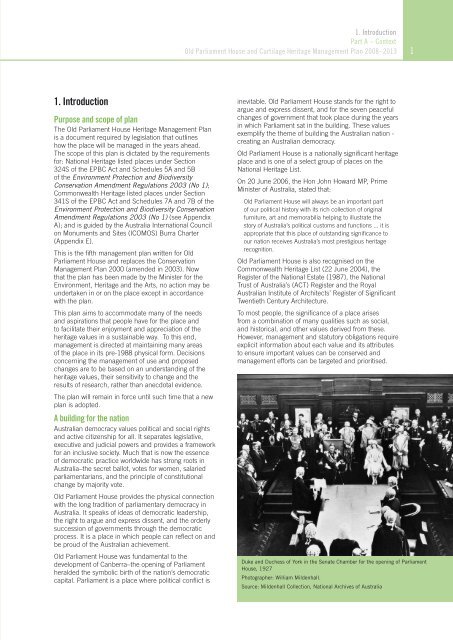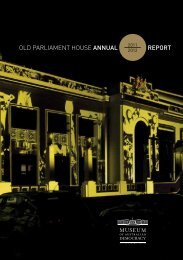OLD PARLIAMENT HOUSE AND CURTILAGE HERITAGE MANAGEMENT PLAN 2008–2013
Heritage Management Plan 2008-2013 - Museum of Australian ...
Heritage Management Plan 2008-2013 - Museum of Australian ...
- No tags were found...
You also want an ePaper? Increase the reach of your titles
YUMPU automatically turns print PDFs into web optimized ePapers that Google loves.
1. Introduction<br />
Part A – Context<br />
Old Parliament House and Curtilage Heritage Management Plan <strong>2008–2013</strong><br />
1<br />
1. Introduction<br />
Purpose and scope of plan<br />
The Old Parliament House Heritage Management Plan<br />
is a document required by legislation that outlines<br />
how the place will be managed in the years ahead.<br />
The scope of this plan is dictated by the requirements<br />
for: National Heritage listed places under Section<br />
324S of the EPBC Act and Schedules 5A and 5B<br />
of the Environment Protection and Biodiversity<br />
Conservation Amendment Regulations 2003 (No 1);<br />
Commonwealth Heritage listed places under Section<br />
341S of the EPBC Act and Schedules 7A and 7B of the<br />
Environment Protection and Biodiversity Conservation<br />
Amendment Regulations 2003 (No 1) (see Appendix<br />
A); and is guided by the Australia International Council<br />
on Monuments and Sites (ICOMOS) Burra Charter<br />
(Appendix E).<br />
This is the fifth management plan written for Old<br />
Parliament House and replaces the Conservation<br />
Management Plan 2000 (amended in 2003). Now<br />
that the plan has been made by the Minister for the<br />
Environment, Heritage and the Arts, no action may be<br />
undertaken in or on the place except in accordance<br />
with the plan.<br />
This plan aims to accommodate many of the needs<br />
and aspirations that people have for the place and<br />
to facilitate their enjoyment and appreciation of the<br />
heritage values in a sustainable way. To this end,<br />
management is directed at maintaining many areas<br />
of the place in its pre-1988 physical form. Decisions<br />
concerning the management of use and proposed<br />
changes are to be based on an understanding of the<br />
heritage values, their sensitivity to change and the<br />
results of research, rather than anecdotal evidence.<br />
The plan will remain in force until such time that a new<br />
plan is adopted.<br />
A building for the nation<br />
Australian democracy values political and social rights<br />
and active citizenship for all. It separates legislative,<br />
executive and judicial powers and provides a framework<br />
for an inclusive society. Much that is now the essence<br />
of democratic practice worldwide has strong roots in<br />
Australia–the secret ballot, votes for women, salaried<br />
parliamentarians, and the principle of constitutional<br />
change by majority vote.<br />
Old Parliament House provides the physical connection<br />
with the long tradition of parliamentary democracy in<br />
Australia. It speaks of ideas of democratic leadership,<br />
the right to argue and express dissent, and the orderly<br />
succession of governments through the democratic<br />
process. It is a place in which people can reflect on and<br />
be proud of the Australian achievement.<br />
Old Parliament House was fundamental to the<br />
development of Canberra–the opening of Parliament<br />
heralded the symbolic birth of the nation’s democratic<br />
capital. Parliament is a place where political conflict is<br />
inevitable. Old Parliament House stands for the right to<br />
argue and express dissent, and for the seven peaceful<br />
changes of government that took place during the years<br />
in which Parliament sat in the building. These values<br />
exemplify the theme of building the Australian nation -<br />
creating an Australian democracy.<br />
Old Parliament House is a nationally significant heritage<br />
place and is one of a select group of places on the<br />
National Heritage List.<br />
On 20 June 2006, the Hon John Howard MP, Prime<br />
Minister of Australia, stated that:<br />
Old Parliament House will always be an important part<br />
of our political history with its rich collection of original<br />
furniture, art and memorabilia helping to illustrate the<br />
story of Australia’s political customs and functions ... it is<br />
appropriate that this place of outstanding significance to<br />
our nation receives Australia’s most prestigious heritage<br />
recognition.<br />
Old Parliament House is also recognised on the<br />
Commonwealth Heritage List (22 June 2004), the<br />
Register of the National Estate (1987), the National<br />
Trust of Australia’s (ACT) Register and the Royal<br />
Australian Institute of Architects’ Register of Significant<br />
Twentieth Century Architecture.<br />
To most people, the significance of a place arises<br />
from a combination of many qualities such as social,<br />
and historical, and other values derived from these.<br />
However, management and statutory obligations require<br />
explicit information about each value and its attributes<br />
to ensure important values can be conserved and<br />
management efforts can be targeted and prioritised.<br />
Duke and Duchess of York in the Senate Chamber for the opening of Parliament<br />
House, 1927<br />
Photographer: William Mildenhall.<br />
Source: Mildenhall Collection, National Archives of Australia




